Wednesday, August 20, 2008
Review

McCarthy, Lloyd D. “In-Dependence” From Bondage: Claude McKay and Michael Manley: Defying the Ideological Clash and Policy Gaps in African Diaspora Relations”


Claude McKay and Michael Manley may seem like strange bedfellows for a study in 20th century politics. Though both born in
Lloyd D. McCarthy’s choice of characters for this analytic dual biography/regional history is ultimately rewarding. McCarthy draws attention to the logical connection between growing up on a colonized, hyper-exploited island and Manley and McKay’s eventual embracing of egalitarian, passionately anti-racist politics. McCarthy makes the case that Manley and McKay represent two archetypal political poles of 20th century
Manley and the Promise of Democratic Socialism
Born to a former Premiere of Jamaica and a well known artist, Michael Manley was given a life of social and political connections across
Manley’s Democratic Socialist model aimed to “Jamaicanize” foreign businesses (state takeover of 51%), expand local capitalism, and nationalize some key institutions. The goal was to reallocate some economic power and provide basic relief to the poor, without scaring away foreign investors or domestic capital completely. Raised as a Fabian socialist, Manley attempted to rebuild

There is also no criticism of the extent to which Manley’s years in office were business as usual for Jamaican politics: cronyism, patronage, street violence by rival party gangs. None of this changed under the rule of “socialist” Manley. As Arthur Lewin pointed out in Monthly Review in the aftermath of Manley’s (first) fall from power, the Manley administration focused the anger of the poor at the rival [conservative] Jamaica Labor Party, not actual economic elites. In short, Manley’s rule served to “mute class struggle”, containing the rebellious mood to the confines of mainstream, two-party politics. McCarthy credits Manley with inventing a nonrevolutionary, “morally-based”, Democratic Socialism perfectly suited for the
There are also undeniably proud moments in Manley’s time in office. His commitment to the liberation struggles in
McKay’s Journey
Claude McKay’s grandparents were born into slavery, and McKay himself was brought up in a rural peasant environment. The language and oral history traditions of rural
The year 1919 would change everything for Claude McKay, a year which also carries a morbid legacy for the radical labor movement and especially the Black community. It was the year of the Palmer Raids, when leftists and immigrants were targeted en mass for deportation. It was also know as the Red—with blood—Summer of 1919, when dozens of Black communities were faced with murderous pogroms and ruthless intimidation campaigns. Hundreds were killed in the violence, which also saw Black resistance to the onslaught. Claude McKay, an aspiring poet working as a waiter, grabbed a pen and wrote a poem at work, titled “If We Must Die”. The poem cried out in anguish at the slaughter being carried out against Black people, and insisted that “if we must die” may it be on our feet, not on our knees. The poem was an incendiary call for vigorous self-defense. It struck a nerve with his co-workers and, via publications such as Max Eastman’s The Liberator, found resonance with Black people and their allies across the country. Despite his deepening connections with the Black left, the labor movement, and radical literary circles, McKay prepared to migrate again, this time to


In the young
When McKay returned to
McKay’s vision, as McCarthy spells out quite clearly through pieces of McKay’s prose, poetry, and political writing, was one of Black liberation and socialism. He believed that capitalism and imperialism had robed the
Manley and McKay
Michael Manley, too, believed that capitalism and imperialism had robbed Black people and people of the Global South of their rights and resources. McKay was inspired by the formation of a world revolutionary movement, while Manley had his eye on international possibilities, too. Manley imagined a European Union-style trading block that would help primarily countries of the Global South. McKay believed that only revolutionary action could wrestle power way from the ruling class, while Manley insisted on an inside-the-system approach that sough a middle path between capital and labor. Both identified their Afro-Caribbean roots as being essential early building blocks towards their radical politics. McKay and Manley both saw themselves as voices for the masses of poor and working class people of African ancestry across the globe, and both saw themselves as stemming the tide of generations of cultural genocide and extreme exploitation.
The many simpatico ways these men’s lives and ideas dovetail each others is looked at in great detail and indeed illuminated by Lloyd McCarthy. The unflattering ways they do not line up, however, are glanced past. McCarthy is unable to see the yawning gap between Manley’s socialist-sounding rhetoric and the zig-zag political realities of his administration. It is a bit simpler to analyze McKay’s politics, as he never wielded state power. His vivid mixture of Black Nationalism, anti-colonialism, and radical socialism found a burning expression on the page, but was never tested on the ground. Therefore it is McCarthy’s light, sympathetic treatment of Manley that is the most suspect.
McCarthy’s book is a joy to read; a rich look at the 20th century Caribbean left as represented by two of it’s most charismatic and brilliant thinkers. The author, it would seem, is simply a little too close to the Manley’s legacy to give it a fair, honest appraisal.
Thursday, July 03, 2008
Utah Philips 1935-2008
 Bruce “
Bruce “
Utah Philips was born into a working class Jewish family in
This dark spiral was intercepted by the Ammon Hennacy, a left-pacifist and organizer with the Catholic Worker movement in
His biding love of folk and country music, particularily of the US West, started early in life. The early 1960’s saw a blossoming of interested in folk music, and Philips increasingly found work playing his guitar and singing at festivals and in coffeehouses. This was in many cases facilitated by his dear friend and fellow folksinger Rosalie Sorells. Also an activist, their collaboration last until Philips final years. Often performing together, Sorrels and Philips made their names in the West Coast folk circuit of the late 1960’s, alongside the late Kate Wolf. Both Wolf and Philips popularized Philips’ songs, including the classic “Rock, Salt, and Nails”, which was also performed by Bob Dylan. Philips let other people interpret his material just as he interpreted the songs of others, an approach common in the folk community. His songs were recorded by American roots music artists from Emmylou Harris to Joan Baez to Waylon Jennings. Legend has it that Johnny Cash wanted to do an entire record of Philips material but

In 1968, perhaps no longer feeling like the only leftist in
Philips felt spiritually and historically connected the labor struggles in the
Philips songs and stories—and stories were as central to a performance as the songs—envisioned the old West of the IWW with vivid intimacy. He understood this to be part of his role in the struggle, the living tribune of the old IWW struggles to organize lumber workers and miners in the 1910’s. Also connected to his relationship with the Western IWW was his love affair with

One of Philips most widely performed and recorded songs was “Used Up”, which tells the story of a worker at the end of his life.
I spent my whole life making somebody richI busted my ass for that son of a bitchHe left me to die like a dog in a ditchAnd told me I'm all used up He used up my labor, he used up my timeHe plundered my body and squandered my mindThen he gave me a pension, some handouts and wineAnd told me I'm all used up They use up the oil, they use up the treesThey use up the air and they use up the seasBut how about you, friend, and how about meWhat's left, when we're all used upPhilips heart was with the poorest layers of the working class, those that had fallen through the cracks or were discarded by capitalism. He and his wife created a soup kitchen just three years ago, and Philips maintained close relationship with homelessness activist projects. Philips had carried with him more than political opposition to the capitalist system, he was emotionally connected to the most devastated.
In 1997 I drove from
A Utah Philips concert was a political event, to be sure. Young fans, punks and activists, sung out loud alongside senior labor veterans and old folkies. His collaborations with contemporary folk icon Ani DiFranco earned him a larger following over the last ten years. Young people radicalized in the era of the anti-globalization protests also took a shine to Philips, eating up his anti-capitalist humor and connection to the past. Utah Philips lived long enough to be a legend in his own time.
One of the performances I saw was at a coffeehouse in Upstate New York in the late 1990’s. Once again, he was performing alongside Rosalie Sorrels. My comrades and I spoke to him at length before the show, totally pulled in by his warmth and irreverent humor. I told him I was from
Conscious revolutionaries, it is sometimes said, help maintain the living memory of the working class. In Philips life we saw the hobo world meet the anti-globalization scene, the IWW meet the world of folk music, and the folk music community met the radical working class subculture.
Friday, January 04, 2008
Review: The Art and Ideas of the Black Panther Party
“The Black Panther Intercommunal News Service 1967-1980”
by David Hilliard Atria Books, 2007
“Black Panther: The Revolutionary Art of Emory Douglas”
Rizzoli, 2007
By Brad Duncan
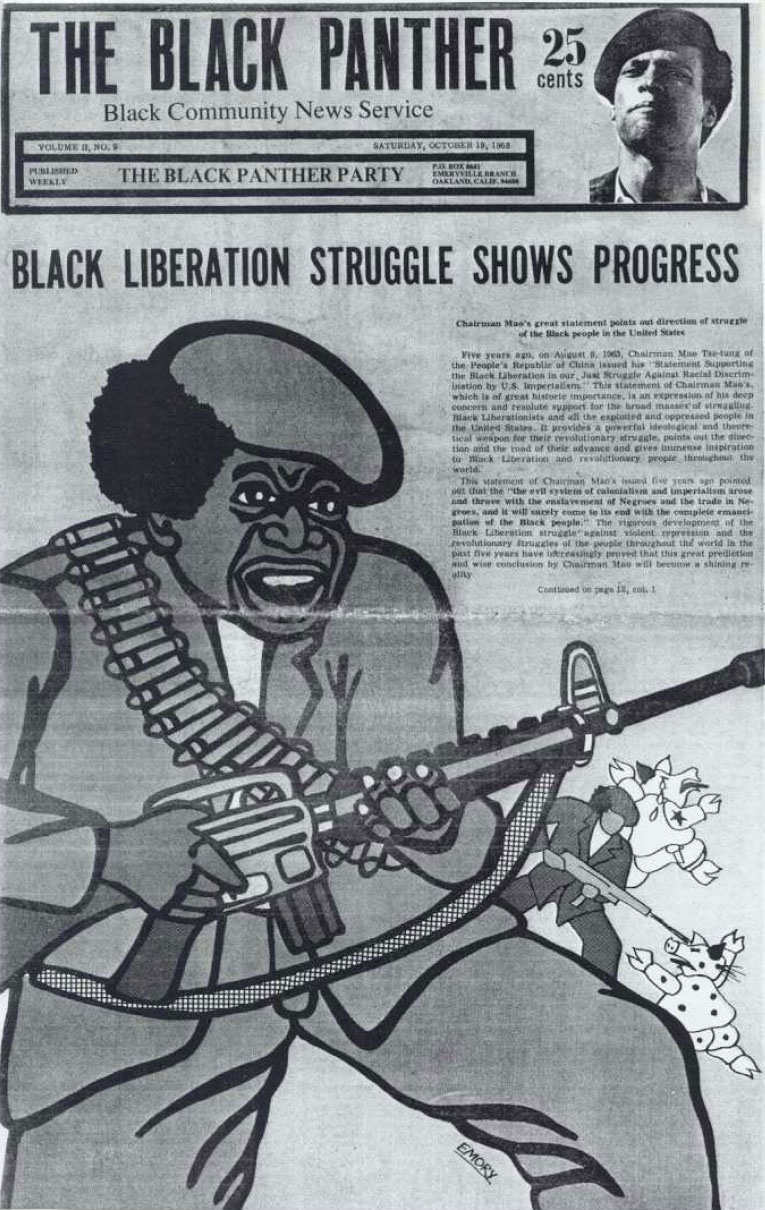
It has now been 40 years since the ‘year of the heroic guerrilla’ when the militant spirit of the late 1960’s and early 1970’s found its most daring expression. Everywhere—it seemed—the revolution had come, and it was time to pick up the gun. The colonial world was shaken by a ‘tri-continental’ (
Although their community ‘survival programs’ delivered clothes and groceries to thousands, the most successful Panther endeavor was their passionate effort to communicate the ideas of the Party and the movement through visual art and Party publications such as The Black Panther newspaper and the Black Panther Intercommunal News Service. Two new books, one collecting front pages and articles from the Party paper and one looking specifically at the art of Minister of Culture Emory Douglas, give an unprecedented look in to these facets of the Black Panther experience.
The two books cover much of the same territory, as
David Hilliard was one of the first Panthers, recruited to the nascent party by his boyhood friend Huey Newton. His new book looks at the Party’s newspaper and specifically hones in on the period between 1969 (dubbed ‘year of the Panther’ by the paper) and 1972, when the movement suffered a debilitating split. With very little in the way of additional commentary, save for a few introductory essays, we are left to read the papers as they appeared. The paper published for thirteen years without missing a weekly issue. The Panthers have no one but themselves to thank for that as they had to build their own press when commercial printers continually caved under state pressure and stopped printing.


From owning their own press the Party grew the paper on an international level, with each weekly issue acting as a line of communication to movements internationally. Leftists and activists of color around the world subscribed or read handed-down copies. Subscriptions were the most essential revenue stream the Party had, especially as the movement begun to ebb in the early 1970’s. Although the paper could readily be found in shops in the Black community or in movement centers by far the easiest way to get a copy back in ’69 was to find one of the thousands of Panthers selling it on the streets of just about every major American city. Lenin would have been proud—the paper truly was the scaffolding of the Party.
Most history books end their look at the Panthers in the early 1970’s, and there is some justification for that. The movement was deathly effected by state harassment and murder as well as internal rifts, rendering the Party halved by 1973. By the mid 1970’s the Black Panther Party was simply no longer able to have a national impact the way they had in 1969-70. It will come as a surprise to some of you that the Party soldiered on until 1980, and so did The Black Panther Newspaper.
The issues of the paper featured in Hilliard’s book reveals in plain view both the incredible promise of the Party and the insidious handicaps the Party faced. The paper demonstrates the powerful solidarity that was being built between the Panthers and other liberation struggles, such as the Asian-American group I Wor Kuen (formerly the Red Guard Party) and the American Indian Movement. Clearly internationalism was infectious as news from the frontlines of
The political handicap most on display here is the cult-like appreciation for the central Panther leaders, namely Huey Newton. Not only is Huey’s face on nearly every masthead, but by 1971 the paper is referring to “the invincible thoughts of Huey P. Newton, Minister of Defense and Supreme Commander…”. Undoubtedly the Party popularized movement heroes, but they also raised some to a level that no human being can reach. Invincible thoughts? The writing was on the wall and Panthers had a leadership-worship problem. This style of regime wrecked havoc on the movement internally.


Another key Panther misstep was the emphasis put on armed struggle. Although armed self defense against the police was a central feature of early Party life, changing gun laws and state violence meant that the Panthers used their weapons less and less as the Party matured and changed. But a glance at one of Emory Douglas’ posters or newspaper covers would suggest otherwise. There are machine guns in nearly every image, generally held high defiantly. This guerrilla pose did not match reality—not only was the American radical scene not ready for a guerrilla army the Panthers’ didn’t have one anyway. The posters and art work make it seem as if the Panthers were a mass paramilitary force with the power to win demands with physical force. It is very easy to understand why weapons were a powerful visual image for oppressed people in a time of repression and resistance. It is quite another for a political movement to make boasts it can’t follow through on. The Panthers had some shotguns, but they were never a real armed force. Emory Douglas’ beautiful guerrilla art could not change this. Nor could his powerful images of armed rebellion alone create the kind of conditions and popular consciousness it would take to lead a successful armed revolutionary movement in the
The front pages Hilliard chose to include give us a look at the Party’s rapid political development from a general ‘Black power’ standpoint, through a Maoist phase and guerrilla phase, and eventually to Huey Newton’s idea of ‘intercommunalism’. Each phase has its own contradictions, to be sure. This is illustrated by support for Soviet-allied African liberation struggles in one issue and a cartoon depicting the
There are a dozen of more new books out about the Black Panther Party, including the excelled Black Panther Party Reconsidered published by Black Classics Press. But these two books say the most by presenting the Panthers as they presented themselves to the world--through their Party press and newspapers.
(below: issues of The Black Panther from 1969)




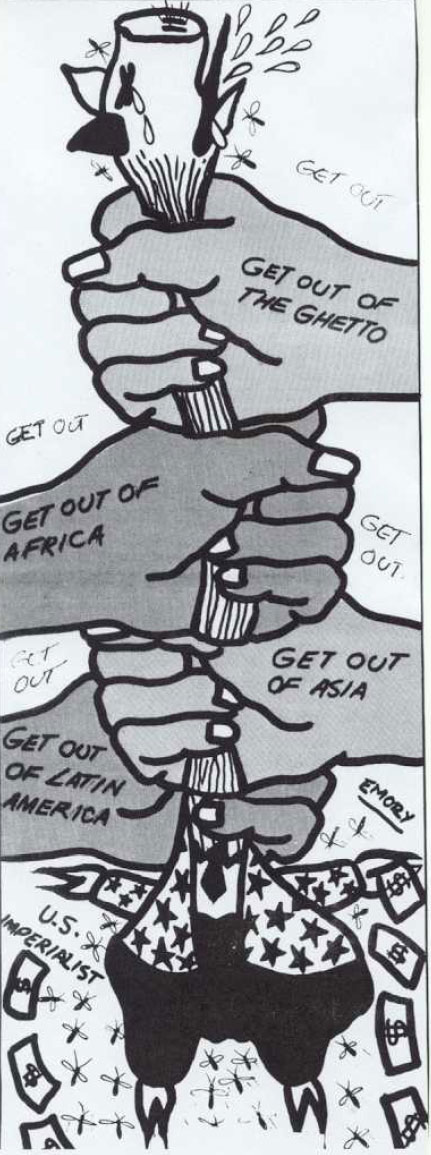
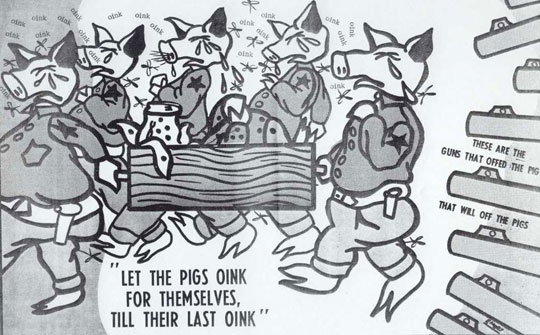
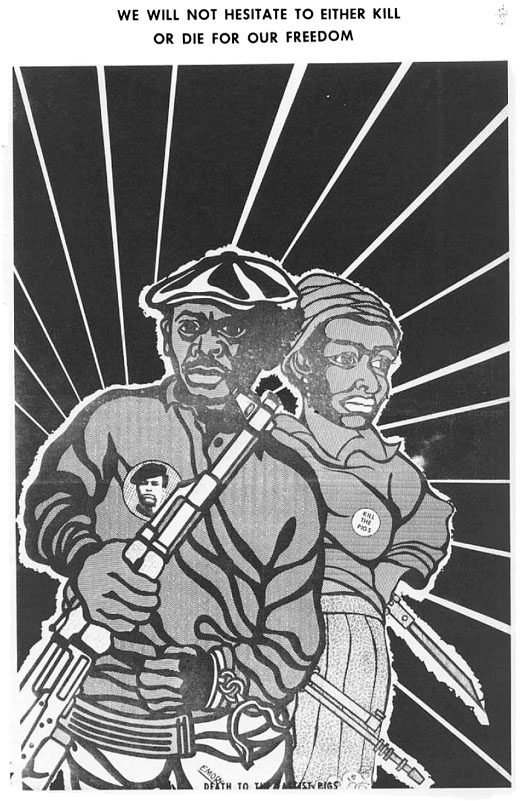
Saturday, December 29, 2007
Review: A dull romp with The Chairman
From Ike to Mao to Chairman Bob
Review"From Ike to Mao: My Journey from Mainstream America
to Revolutionary Communist"
Insight Press, 2006

Around 400 pages into his painfully self-absorbed and unfunny autobiography Chairman Bob Avakian briefly considers the issue of personality cults. Funny, that—as his Revolutionary Communist Party focuses almost solely on the “ideas” of this one man. He spells it out pretty simply: workers accept that some people are special. Some basketball players are simply the best, some scientists are simply brilliant, and some Maoists are bigger than others.
Ostensibly, this tome tells the story of a wholesome American boy. A young, cherubic sport-enthusiast who loved mom and the President. The New Left intervened and before long he was shrill, ambitious leader of the Maoist “new communist movement” collective based in the Bay Area called Revolutionary Union. At this point the story could belong to many left-swerving baby boomers. Like thousands of others, as SDS collapsed “Marxism-Leninism” beckoned. It was now time to build a ‘party of a new type’ which—it was hoped—would successfully replicate the parties of the old type.
Avakian, like Forest Gump with a little red book, paints himself in to the middle of the action. According to From Ike to Mao Avakian was even asked to join the Black Panther Party’s “secret national leadership” by none other than Eldrige Cleaver. The Panthers weren’t ready for him, Avakian intones, because his revolutionary vision chaffed against the Panthers conservatism. At one point Avakian concocts an unverified story about taking the ‘two line struggle’ right into a Panther meeting. He barbequed their pork-chop nationalism with his white-hot MLMTT.


One particularly telling anecdote comes from unity meetings held between Avakian’s RU and a number of majority Black and Latino groups. In a debate over who should represent RU, Avakian insists it should be him—because he’s white. These Black and Latino comrades needed more white people in their lives, due to their head-in-the-sand nationalism. They needed to “get comfortable” with white leadership. But then again the RCP aligned itself with
Eventually, after a couple years attempting to pull other collectives into its orbit, the RU decided to go it alone and declared itself the official revolutionary vanguard of the
Of course Avakian’s RCP—and eventually it was solely Avakian’s—was not alone. From possibly hundreds of Maoist-influenced collectives, nearly a dozen made similar declarations. By the dawn of the 1980’s the “new communist movement” consisted of a handful of self-declared vanguards.
But don’t read this book to learn that history. Read Max Elbaum’s excellent Revolution in the Air. All you’ll get here is an infantilizing, hand-holding walk through why the RCP triumphed.

(above) American Maoism for beginners
A lot of people will claim the RCP went through a long ultra left period in the 80’s and 90’s. I don’t think so, I always mention the Shinning Path at City Council meetings. And where did the black motorcycle jackets and red kafeiyas go? And why is there basically only one photograph of Chairman Bob made available? Are we to believe he’s anti-revisionism’s Dorian Gray?
This book does not give you any of the inside scoop you were hoping for. No peeks inside rigorous criticism/self-criticism sessions, no believable snapshots of life with Bob the Exile in
What I want to know is why is a split from the mid-1970’s given so much ink? After Mao died the RCP was divided over the new leadership in
Not surprisingly, this book does nothing to explain what the RCP is today and why, over the last two years, Avakian has gone from being undeniable leader to positively cultish Godhead. Avakian was always one to plaster his face around town, but there now exists a climate of total worship inside the RCP. It’s cultivated, clumsy, and curious.
Word on the street is it’s a cushion against a bombshell.
Let me explain.
If there is a successful Maoist movement in the world right now it is clearly the Nepalese movement. Of course in the true tradition of neo-Stalinism they ended up joining the capitalist government right when victory seemed certain, but that’s for another article. Anyway, everyone loves the Nepalese—they keep Maoism relevant. The RCP passionately promoted the Nepalese movement for years, selling their publication, covering their every utterance in their press, and otherwise publicly associating themselves with this broadly supported Maoist movement.
But here’s the problem: the Nepalese are on to Avakian. They may share an international—the Revolutionary International Movement—but they no longer feel the love. The Nepalese charge that Avakian is a cult leader whose ideological contributions amount to smoke and mirrors. Sensible, right? For the last couple years the Nepalese have been preparing to call Avakian out on the carpet, which would shatter the RIM. By the time the criticism/self-criticism hits the fan, Avakian hopes, he’ll be properly insulated from the criticism, thus saving his fiefdom.
Neither does this bland, creepy autobiography address the RCP’s transition from confrontationalist pose in the 1980’s to the celebrity loving “world can’t wait” fear mongerers they are today. It’s a long way from hailing peoples’ war to handing Sean Penn an orange jumpsuit.

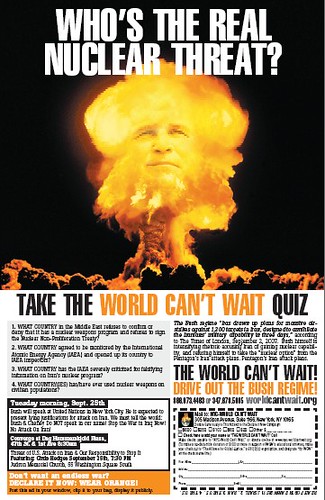
(above) The paranoid liberalism of today's RCP, celebrities sold separately
Remember these are the folks whose newspaper masthead featured weapons well into the 2000’s, and here they are with pro-Democratic Party, lowest common denominator pandering. How does this happen? Well, how did it happen to the Nepalese Maoist movement?
Sunday, December 23, 2007
Radical gay activist Bob Kohler dead at 81
The Many Lives of Bob Kohler
By Brad Duncan

Liberation movements in the United States lost a brave and vibrant participant in the death of Bob Kohler, a leading figure of the American Gay Liberation Movement.
Bob lived dozens of lives in his 81 years on the planet. Although Bob was best known as an early leader of the Gay Liberation Front he was also a talent representative for mostly Black artists in the early 1960’s, a vintage clothing store owner, World War II veteran, a talented and empathetic listener, bath house proprietor, peoples’ historian, Stonewall uprising participant, and a link between the gay struggle and other liberation struggles. .
Much like the late New York activist and fellow Irish-American George Harrison, Kohler was a figure whose work touched on a wide range of social movements. His movement work stretched from CORE in the early 1960’s to ACT-UP in the 1980’s and 1990’s. Perhaps more than anything he want gay people who wanted freedom to link their struggle with all other people who want freedom. Beyond his extensive involvement with CORE and later the Black Panthers, Bob championed the struggles of New York’s Puerto Rican community, fought for immigrant rights, animal rights, and was last arrested at a demonstration against the police murder of African immigrant Amadou Diallo in 1999.
He was the first to build a bridge between the GLF and the Black Panthers, and he also led a demonstration against sexism inside a Panther meeting. He was determined to both challenge the left and radicalize it. The GLF pushed the issue with the left by refusing to be sidelined in the movement. In the late 1960’s Bob organized pickets against the Village Voice and won his demand for the right to use the word ‘gay’ in an advertisement.
An oral history from the early 1990’s speaks vividly to the era:
“Basically, we went where angels feared to tread… We organized marches and participated in other people’s marches. We had fistfights with the Communist Party at a demonstration once because they said that we were embarrassing them by being there.” (1)
One of Bob’s many lives was as an oral historian of the gay community in New York. He was connected to the street kids; he listened to them and understood them, just as he connected with activists and all types of social outsiders. He stood with his feet stretching across multiple generations of gay New York, and was an important community elder.
In the same oral history, Bob explains why dance parties were nessesarry fund raisers in the early days of the gay liberation movement:
“We would sometimes make as much as a thousand dollars, which was big money in 1970. Usually the money during the dance was kept in Sylvia’s panty hose or in my back pocket. We used the money as bail. We’d get a call that two Black Panthers had been arrested. One of us would take the money, go down, and bail them out. Or women were striking at the telephone company and one was arrested and beaten up. Or someone wanted to start a youth organization. We’d throw a dance and give them the proceeds. What little money we had we’d keep under my bathtub because we were afraid of banks”. (2)
Fighters for human liberation everywhere morn his passing, although no one could accuse him of leading a short or unproductive life.
Bob Kohler, Presente!
(1) and (2) from Over the Rainbow: Lesbian and Gay Politics in America Since Stonewall Boxtree, London 1993






